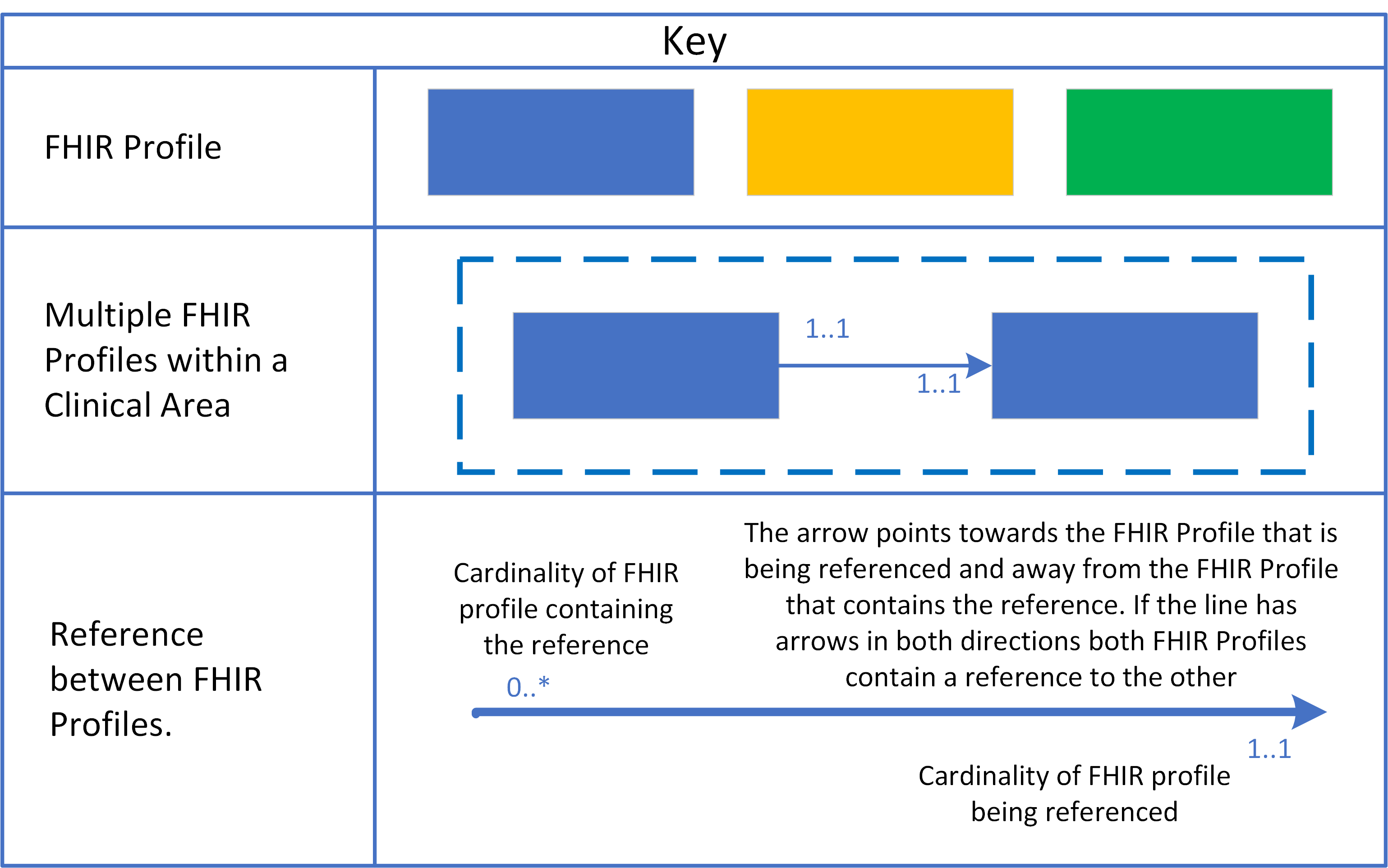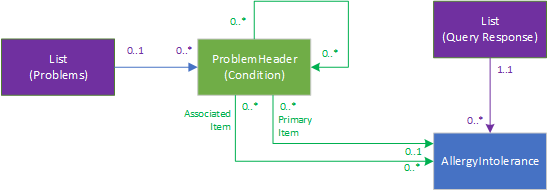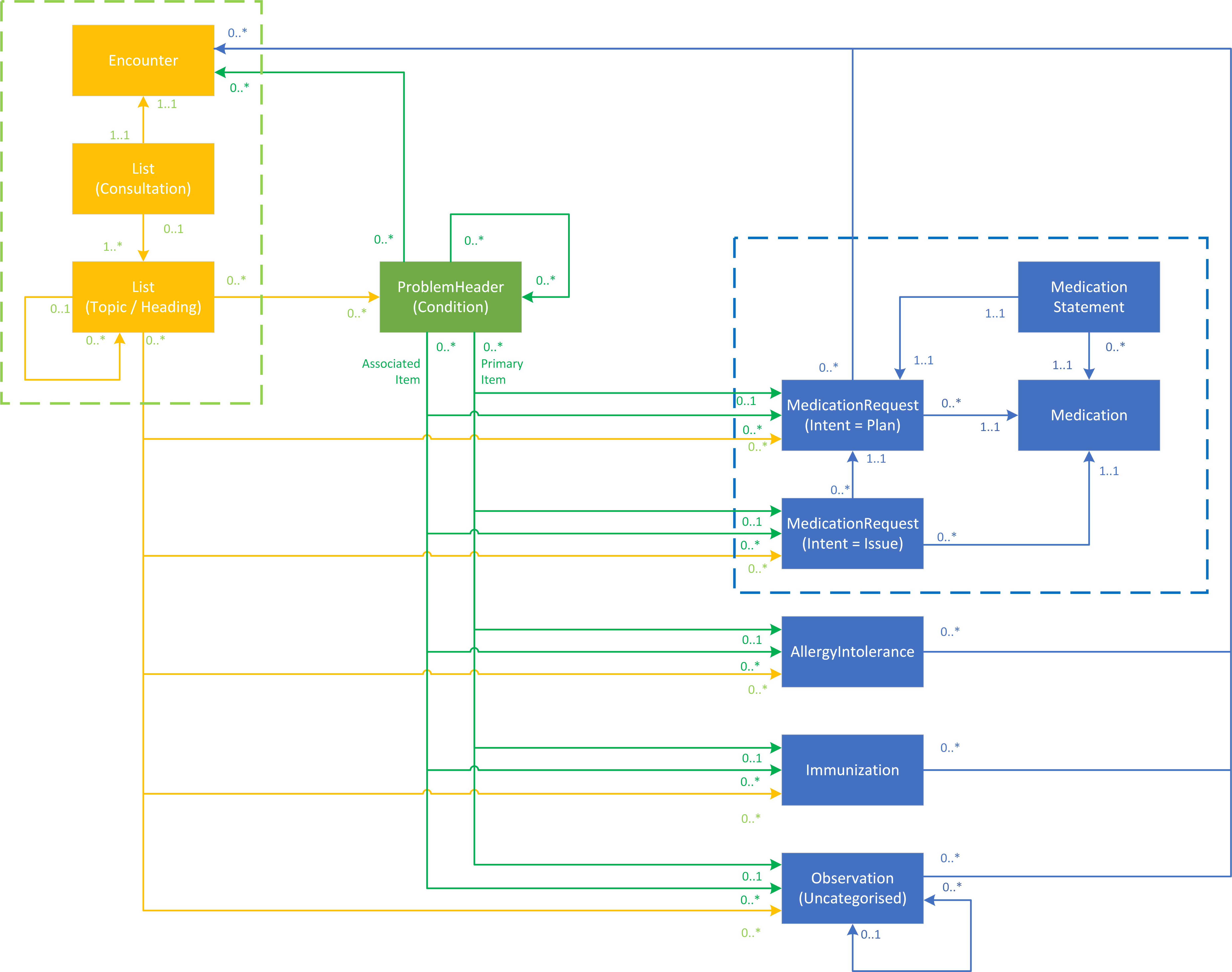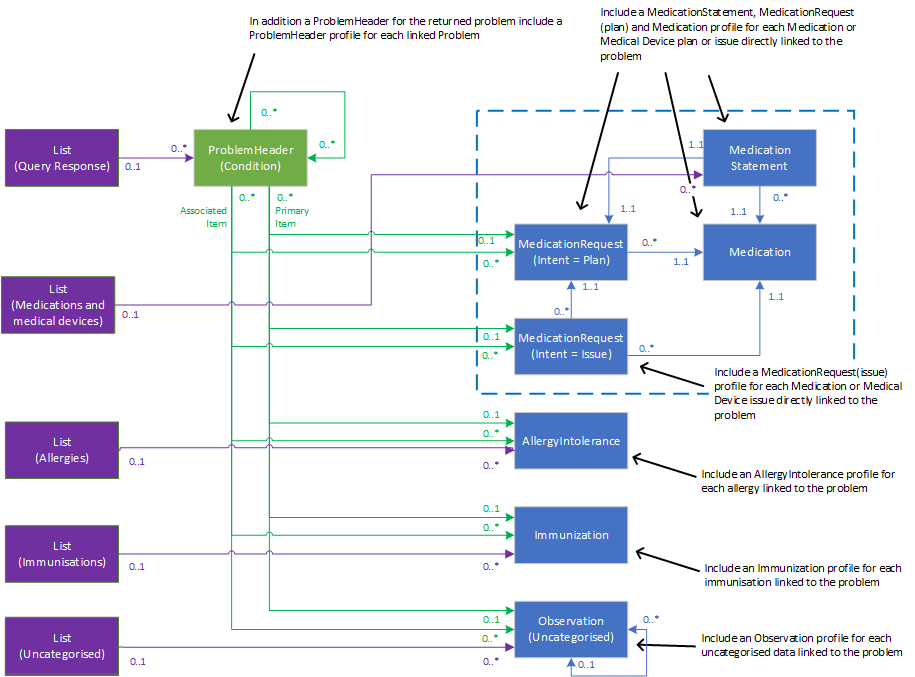Linkages
One of the purposes in developing the FHIR® profiles is to ensure that clinical data is, as much as possible, presented the same way regardless of the provider system. This ensures the consuming system (and clinician) will always know where to look for each type of information.
However, information about the patient is not just held within the profiles but in how those profiles are linked together.
For example, linking a medication to a problem means that as well as the record showing what the patient is taking, it also explains why they are taking it.
For a consuming system to be able to interpret this linkage information correctly, it needs to be presented in the same way regardless of the providing system.
GP Connect FHIR® model
To support this, GP Connect has developed a FHIR model that identifies all the GP Connect FHIR profiles and how they are related together to store the patient record.
The model currently covers Consultations, Problems, Medications and Medical Devices, Allergies, Immunisations and Uncategorised Data. Other clinical areas will be added as they are developed.

The relationships between two FHIR profiles are recorded in only one of the linked FHIR profiles (similar to in a relational database management system). This is shown by the direction of the arrow in the FHIR model.
For example, the MedicationStatement profile contains a field that can be used to look up the linked Medication. There is no field in the Medication profile that can be used to look up the linked MedicationStatement.
FHIR profiles returned on query
When a consumer system requests data on a clinical area the information is returned across a number of FHIR profiles. Choosing which FHIR profiles to return is a balancing act between including enough linked profiles to give the consumer system a comprehensive response to their query but not including so many linked profiles as to swamp the consumer system with data.
The three main considerations used to decide which data to return for each clinical area were:
- include all the FHIR profiles required to fully describe the requested clinical area
- include the FHIR profiles required to define all the linkages from the requested clinical area
- include the FHIR profiles from linked clinical areas where they are key to understanding the requested clinical area For each clinical area in a query that returns data a list should be generated that contains links to all data items returned for that clinical area.
Dealing with confidential items
Any clinical area that has not returned an item as it was confidential SHALL populate the relevant list with the warning code confidential-items as specified in the resource population fundamentals page.
Problems are an exception to this rule. It is only necessary to indicate if a problem has not been returned due to confidentiality when responding to a specific problem query. Where problems are due to be returned as they are linked to an item returned as part of a query for a different clinical area, e.g. a medication query, but are omitted for confidentiality reasons MUST NOT be marked with a warning code.
The reason for the exception in the case of problems is due to the fact that problem linkages are applied manually and are therefore not consistent across the GP estate. As not everything that could be considered a problem will be linked then to warn that a problem was missing could lead to confusion as this is also possible when the warning is not present.
Consultations
When GP Connect returns a consultation it will supply the metadata of the consultation and all the clinical data that was recorded during the consultation.
The response to the query includes:
- A
Listprofile containing references toEncounterfor every Consultation that met the search criteria - A
Listprofile for each clinical area that data exists in the bundle
For each Encounter referenced in the List profile:
- The
Encounterprofile of the Consultation - The
Listprofiles that describe the structure of the Consultation - The
ProblemHeader (Condition)profile of any directly linked Problems - The
MedicationRequest,MedicationStatementandMedicationprofiles of any linked Medications or Medical Devices- Always include the
MedicationStatement,MedicationRequest(intent = plan) andMedicationprofiles - Only include
MedicationRequest(intent = order) for directly linked issues - Include the
ProblemHeader (Condition)profile of any Problems linked to the returned Medications and Medical Devices
- Always include the
- The
AllergyIntoleranceprofile of any linked Allergies- Include the
ProblemHeader (Condition)profile of any Problems linked to the returned Allergies
- Include the
- The
Immunizationprofile of any linked Immunisations- Include the
ProblemHeader (Condition)profile of any Problems linked to the returned Immunisations
- Include the
- The
Observationprofile of any linked Uncategorised Data- Include the
ProblemHeader (Condition)profile of any Problems linked to the returned Uncategorised Data
- Include the
- All administrative profiles referenced directly (or via another administrative profile) by any of the clinical profiles included above.
- Include
Patient,Organization,PractitionerRole,PractitionerandLocation.
- Include
Where a Consultation links to a profile that is not yet supported by the provider system then it is not included in the response. Details on how this is done can be found in the Consultation Guidance.
Clinical items within the Consultation are always included in the response regardless of their inclusion/exclusion in other parts of the query. So, for example, if a consumer requests a Consultation that contains a Medication but does not explicitly request Medications in the query, the provider will still include the Medication contained in the Consultation as part of its response.
Problems
When GP Connect returns a problem it will supply the metadata and description of the problem and all the clinical data that has been linked to the problem.
The response to the query includes:
- A
Listprofile containing references toProblemHeader (Condition)for every Problem that met the search criteria - A
Listprofile for each clinical area that data exists in the bundle
For each ProblemHeader (Condition) referenced in the List profile:
- The
ProblemHeader (Condition)profile of the Problem - The
ProblemHeader (Condition)profiles of any directly linked Problems - The
MedicationRequest,MedicationStatementandMedicationprofiles of any linked Medications or Medical Devices- Always include the
MedicationStatement,MedicationRequest(intent = plan) andMedicationprofiles - Only include
MedicationRequest(intent = order) for directly linked issues
- Always include the
- The
AllergyIntoleranceprofile of any linked Allergies- Include the
ProblemHeader (Condition)profile of any Problems linked to the returned Allergies
- Include the
- The
Immunizationprofile of any linked Immunisations- Include the
ProblemHeader (Condition)profile of any Problems linked to the returned Immunisations
- Include the
- The
Observationprofile of any linked Uncategorised Data- Include the
ProblemHeader (Condition)profile of any Problems linked to the returned Uncategorised Data
- Include the
- All administrative profiles referenced directly (or via another administrative profile) by any of the clinical profiles included above
- Include
Patient,Organization,PractitionerRole,PractitionerandLocation
- Include
Where a Problem links to a profile that is not yet supported by the provider system, then it is not included in the response. Details on how this is done can be found in the Problem Guidance.
Clinical items linked to the Problem are always included in the response regardless of their inclusion/exclusion in other parts of the query. So, for example, if a consumer requests a Problem that links to a Medication but does not explicitly request Medications in the query, the provider will still include the Medication linked to the Problem as part of its response.
Medications and medical devices
When GP Connect returns a medication or medical device it will supply the prescription plan information. If asked for by the consumer, GP Connect will also return all the prescription issues made under the plan.
The response to the query includes:
- A
Listprofile containing references toMedicationStatementfor every Medication and Medical Device that met the search criteria - A
Listprofile containing references to eachProblemHeaderthat is contained in the bundle
For each MedicationStatement referenced in the List profile:
- The
MedicationStatementprofile of the Medication or Medical Device - The
MedicationRequest(intent = plan) profile of the Medication or Medical Device - The
Medicationprofile of the Medication and Medical Device - Where requested, the
MedicationRequest(intent = order) profile for every issue - The
ProblemHeader (Condition)profiles of any directly linked Problems - All administrative profiles referenced directly (or via another administrative profile) by any of the clinical profiles included above
- Include
Patient,Organization,PractitionerRole,PractitionerandLocation
- Include
Allergies
When GP Connect returns an allergy it will supply all the allergy data.
The response to the query includes:
- A
Listprofile containing references toAllergyIntolerancefor every active Allergy - Where requested, a
Listprofile containing references toAllergyIntolerancefor every ended Allergy - A
Listprofile containing references to eachProblemHeaderthat is contained in the bundle
For each AllergyIntolerance referenced in either of the List profiles:
- The
AllergyIntoleranceprofile of the Allergy - The
ProblemHeader (Condition)profiles of any directly linked Problems - All administrative profiles referenced directly (or via another administrative profile) by any of the clinical profiles included above
- Include
Patient,Organization,PractitionerRole,PractitionerandLocation
- Include

Immunisation
When GP Connect returns an immunisation it will supply all the immunisation data.
The response to the query includes:
- A
Listprofile containing references toImmunizationfor every Immunisation - A
Listprofile containing references to eachProblemHeaderthat is contained in the bundle
For each Immunization referenced in the List profile:
- The
Immunizationprofile of the Immunisation - The
ProblemHeader (Condition)profiles of any directly linked Problems - All administrative profiles referenced directly (or via another administrative profile) by any of the clinical profiles included above
- Include
Patient,Organization,PractitionerRole,PractitionerandLocation
- Include

Uncategorised data
When GP Connect returns uncategorised data it will supply all the data about the uncategorised data.
The response to the query includes:
- A
Listprofile containing references toObservationfor every Uncategorised Data that met the search criteria - A
Listprofile containing references to eachProblemHeaderthat is contained in the bundle
For each Observation referenced in the List profile:
- The
Observationprofile of the Uncategorised Data - The
ProblemHeader (Condition)profiles of any directly linked Problems - All administrative profiles referenced directly (or via another administrative profile) by any of the clinical profiles included above
- Include
Patient,Organization,PractitionerRole,PractitionerandLocation
- Include

Duplicate returned profiles
Where the same instance of a profile is returned from multiple query responses (for example a medication is returned as part of the medication search and the consultation search), it will only be included once in the response message.
The details on how this is implemented in an API can be found in the API definition.




